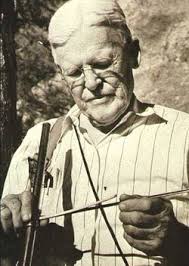A.E. Douglass
| A. E. Douglass | |
|---|---|
 |
|
| Born |
July 5, 1867 Windsor, Vermont |
| Died | March 20, 1962 (aged 94) Tucson, Arizona |
| Nationality |
|
| Alma mater | Trinity College, Hartford, Connecticut |
| Known for | Founding the discipline of dendrochronology Discovering a correlation between tree rings and the sunspot cycle |
| Scientific career | |
| Fields |
Astronomy Dendrochronology |
| Institutions |
University of Arizona Lowell Observatory |
A. E. (Andrew Ellicott) Douglass (July 5, 1867 in Windsor, Vermont – March 20, 1962 in Tucson, Arizona) was an American astronomer. He discovered a correlation between tree rings and the sunspot cycle, and founded the discipline of dendrochronology, which is a method of dating wood by analyzing the growth ring pattern. He started his discoveries in this field in 1894 when he was working at the Lowell Observatory. During this time he was an assistant to Percival Lowell, but fell out with him when his experiments made him doubt the existence of artificial "canals" on Mars and visible cusps on Venus.
Craters on the Moon and Mars are named in his honor.
After a 5-year hiatus from astronomy, Douglass left Flagstaff, Arizona in 1906 and accepted a position as Assistant Professor of Physics and Geography at the University of Arizona in Tucson, Arizona. Almost immediately upon his arrival in Tucson, Douglass re-established his astronomical research programs using an 8-inch refracting telescope on loan from the Harvard College Observatory and actively began to pursue funding to construct a large research-class telescope in Tucson. Over the next 10 years Douglass was unable to secure funding from the University and the Arizona Territorial (and later State) Legislatures. During this period Douglass served the University of Arizona as Head of the Dept. of Physics and Astronomy, Interim President, and finally Dean of the College of Letters, Arts, & Sciences.
On October 18, 1916, University President Rufus von KleinSmid announced that an anonymous donor had given the University US$60,000 "... to be used to buy a telescope of huge size"; the donor was later revealed to be Mrs. Lavinia Steward of Oracle, Arizona, a wealthy widow with an interest in astronomy and a desire to commemorate her late husband, Henry Steward. Douglass made plans to use the Steward gift to construct a 36-inch Newtonian reflecting telescope. The Warner & Swayze Company of Cleveland, Ohio was contracted to build the telescope, but the United States entry into World War I delayed the contract since Warner & Swayze had war contracts that took priority. Until this time expertise in large telescope mirror making was in Europe, but the war made it impossible to contract with a European company, so Douglass had to find an American glass company willing to develop this expertise. After a couple of failed castings, the Spencer Lens Co. of Buffalo, New York produced the mirror for the Steward Telescope.
...
Wikipedia
